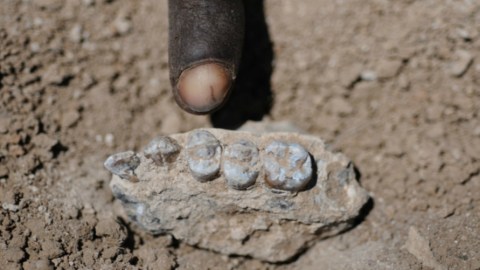Introducing Australopithecus Deyiremeda, Your Ancient and Distant Cousin

If “Australopithecus deyiremeda” had popped up during this week’s Scripps National Spelling Bee, who knows if Vanya and Gokul would have walked out of that room with a first place share. Luckily for them, it didn’t, probably because 1) Scripps has no love for Linnaean taxonomy, and 2) hardly anyone had heard of it prior to a major announcement this week.
Australopithecus deyiremeda is a new human ancestor species, although actually it’s not new at all. It’s old. Way old: 3.3 to 3.5 million years old. The only thing new about it is our knowledge that it ever existed. Credit for the discovery goes to a curator at the Cleveland Museum of Natural History:
“An international team of scientists, led by Curator of Physical Anthropology Dr. Yohannes Haile-Selassie, has discovered a 3.3 to 3.5 million-year-old new human ancestor species. Upper and lower jaw fossils recovered from the Woranso-Mille area of the Afar region of Ethiopia have been assigned to the new species Australopithecus deyiremeda. This hominin lived alongside the famous “Lucy’s” species, Australopithecus afarensis. The species will be described in the May 28, 2015 issue of the international scientific journal Nature.”
Dr. Haile-Selassie explains that there are two reasons why this discovery is so important. First, it’s proof that “Lucy” did not walk alone. There was at least one other contemporary species at the same time in the same place. Second, it reveals that there was diversity among early hominid species. Third, that certain traits we associate with later hominids actually developed earlier in the evolutionary cycle.
While there’s likely a lot more to learn about this “new” species, the evidence uncovered by Dr. Haile-Selassie’s team is enough to shake up our known understanding of human origins. I’ve included some additional resources below if you’d like to learn more. And for all you spellers out there, remember that the “y” comes before the “i” in Australopithecus deyiremeda.
Preview the article in Nature.
Read more at CMNH.
Photo: Fossilized teeth, credit: Dr. Haile-Selassie
Below, paleoanthropologist Donald Johanson describes “Lucy,” the Australopithecus afarensis skeleton he discovered in 1974:





